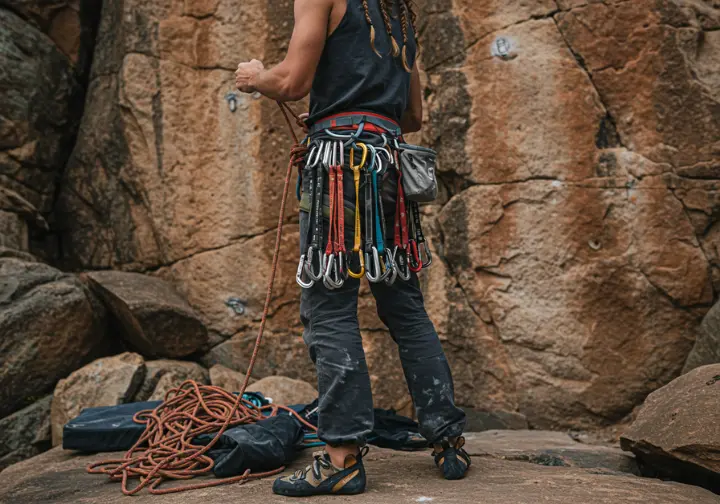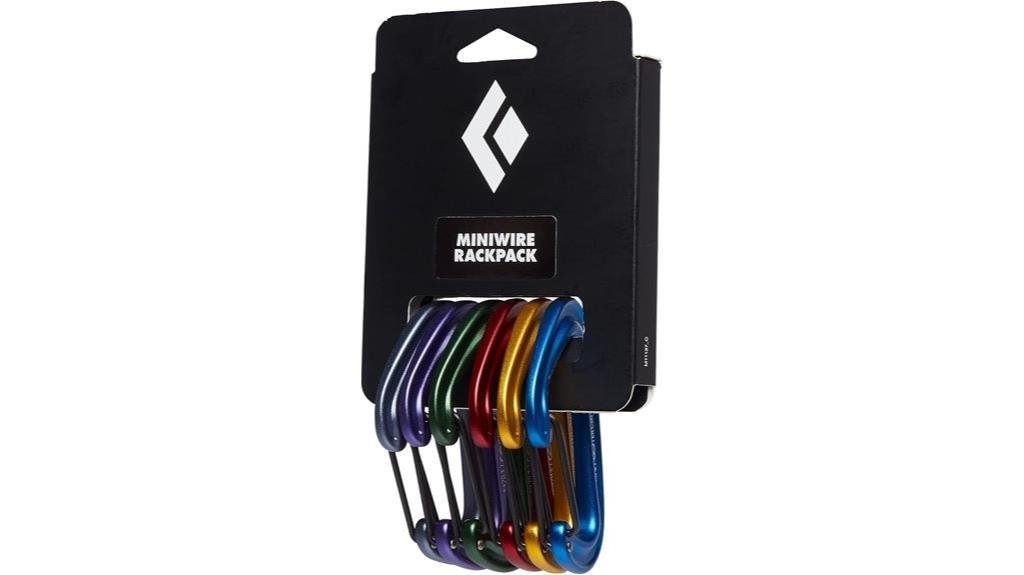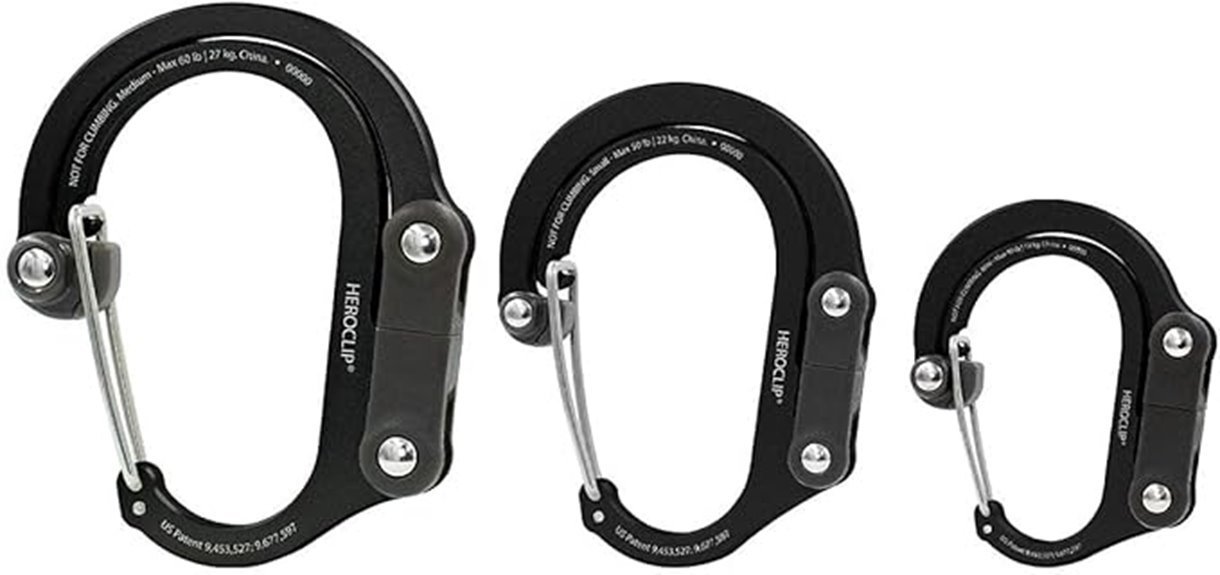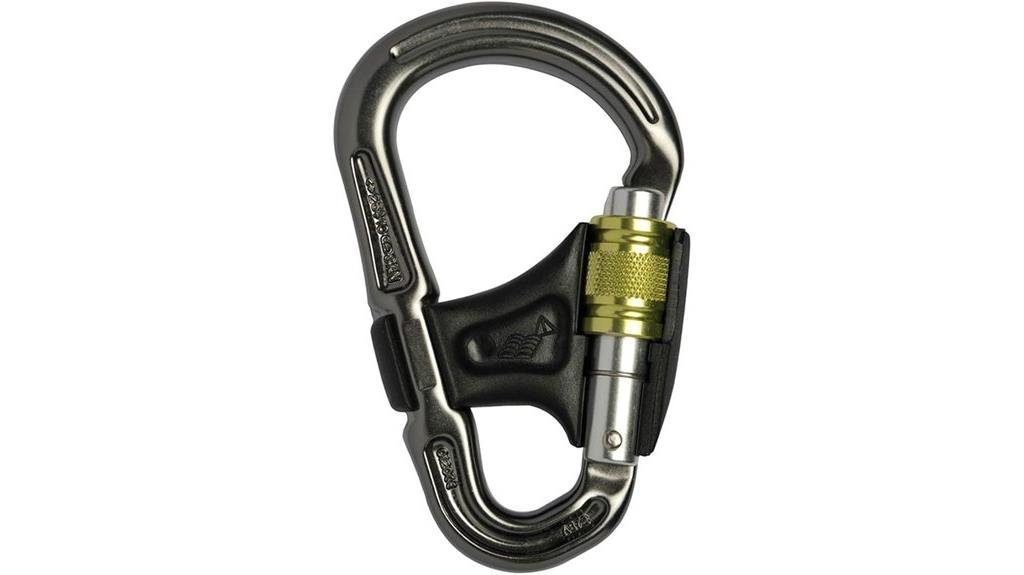You need the right carabiner; it’s this simple. Knowing what carabiner for climbing is essential for safety. Locking carabiners? Non-negotiable for belaying. Forget those cheap, rusty things. D-shapes are strong and light. Oval carabiners are great for pulleys. Your climbing style matters. Sport climbing? Lightweight is your friend. Trad? Versatility wins. Alpine climbing? Think wire-gate. Don’t be this person who doesn’t inspect their gear. Black Diamond RockLocks are burly, Petzl Attaches are versatile. You’ll climb safer, and maybe better, with our top recommendations.
In this article
Your Essential Guide to Choosing the Right Carabiner

Envision this: you’re 30 feet up, your muscles are screaming, and you’re about to make the move of your life. All that’s between you and disaster is your climbing gear, particularly, that carabiner. Hold on! Are you using the right one?!
Picking carabiners shouldn’t feel like defusing a bomb, right? You’re a climber, not an engineer! There’re so many; it’s overwhelming.
Round, pear-shaped, twist lock, auto lock, locking carabiner, non-locking; the list is endless.
Fear not, since this guide’s gonna simplify your life and keep you safe. We’ll break down the types, their uses, and how to pick the best carabiner for your climbing needs. UIAA certification and strength ratings will be covered, so you can be sure you’re making a safe choice.
Think of your cinch, rope, a carabiner, and their breaking strength. Consider your weight. Let’s get you dialed in.
Understanding the Fundamentals of Climbing Carabiners

So, you think all carabiners are created equal—how cute! You’ve got locking and non-locking, different shapes, and gate types; ignoring all that’s just foolish. Four locking carabiners are recommended, especially when building anchors or connecting to protection.
Don’t even get me started on materials and strength ratings, since face it, safety isn’t optional, it’s the whole freakin’ point, right?
Locking vs. Non-Locking Carabiners: A Critical Distinction
You’ve gotta know the difference between these two. Locking carabiners have a gate which locks; seriously, it’s this simple! Think screw-lock, twist-lock, and auto-locking carabiner types. These are your go-to’s for belaying, rappelling, and building solid anchors – situations where a carabiner failure ain’t an option. Like, ever! Conversely, a non-locking carabiner (or snap-link) is simpler, but less secure.
Use locking ‘biners on your personal anchor system (PAS). No brainer! So, where do you use the non-locking ones? You’d clip quickdraws. What about those pesky, fragile gate carabiners? Non-locking. Racking gear? Sure, since an open gate here won’t send you plummeting. Many prefer keylock carabiners to prevent snagging while clipping bolts.
Understand this these tools aren’t interchangeable. Choose wisely or face the consequences.
The Significance of Carabiner Shapes for Climbing
You might think all carabiners are created equal, but get this: shape matters. The carabiner body really dictates how it interacts with gear, and eventually its strength. Wanna know why? Here’s the lowdown.
- Asymmetrical carabiners: These d-shaped carabiners are champions. Strong and light. You can’t go wrong.
- D-shaped carabiners: Reliable option and hold loads well. Good for belaying with standard devices.
- Oval carabiners: Not the strongest guys, but work well with pulleys. Symmetry is key, like it or not.
- Pear-shaped carabiners: The HMS carabiners, or pear-shaped carabiner all-stars. Use them for belaying, for sure! Various locking mechanisms enhance safety during climbs.
Each shape carabiner truly caters to a specific need. Don’t underestimate the shape.
Exploring Carabiner Gate Types: Straight, Bent, and Wire
Carabiner gates? You’ve got choices! Straight-gate carabiners are your workhorses; durable for racking gear and clipping bolts. Think of ’em as the reliable friend you bring everywhere. Bent-gate carabiners make clipping the rope easier – crucial for quickdraws.
Then there are wire gate carabiners. Oh, the joys of lightweight carabiners! Ideal if you’re counting every ounce on a long climb, plus they don’t freeze up when they’re climbing. A solid gate means a keylock or not? It matters! Keylocks prevent snagging. Choose your gear wisely, it can save your life.
Carabiner Materials, Strength Ratings and Safety Standards
It all comes down to what they’re made of, right? Common materials: aluminum alloy (light, the go-to) and steel (strong, heavy). You’ll find strength ratings – crucial, pay freakin’ attention! So, what do those numbers actually mean? They’re measured in kN.
Here’s the breakdown:
- Major axis strength: The big cheese, loaded lengthwise.
- Minor-axis strength: Sideways loading? Don’t even think about it. Weak!
- Open-gate strength: Gate open? Yikes, even weaker.
Don’t get them mixed up. Open-gate strength is your enemy.
These ratings matter as your life depends on it. CE and UIAA certifications matter too—they’re safety stamps. Carabiners, like harnesses from reputable brands, must meet UiAA standards for safety and performance. Avoid loading near the breaking point! Your gear is your friend, use wisely!
Choosing The Right Carabiner For Your Climbing Style and Needs

Think you can just grab any old biner? Absolutely not! You’ve got to match your carabiner to your climbing style – sport, trad, maybe even that weird mixed stuff; otherwise, it’s game over.
Weight matters, believe it on this one (unless you enjoy lugging anchors which weigh more than you).
Matching Carabiners to Specific Climbing Disciplines
So, you wanna climb? You’ll need to match your carabiners to your discipline. Makes sense, right? Don’t use what everyone else does. You’ve got to choose the right tools. Or else.
If you’re sport-climbing, quickdraws with lightweight, non-locking ‘biners are key. Bent gates? Sure, but keylocks matter. For trad-climbing, think versatile. Locking carabiners are your friends for anchors, believe me.
Here’s the breakdown:
- Sport Climbing? Quickdraws! Avoid rope drag.
- Trad Climbing? Screw-lock. Versatility is your friend.
- Alpine Climbing? You’d better be shaving weight with wire-gates. Otherwise, lug it yourself.
- Gym Climbing? Durable everything. And durable climbing shoes.
For alpine climbing, weight is EVERYTHING. Wire-gates everywhere, lighter ropes, smaller rigging. To minimize impact during falls, consider using dynamic ropes in appropriate scenarios.
Believe my expertise. Climbing ropes and a belay device with a proper locking carabiner. Bottom line: know what you’re doing, and what you need. No “maybe” here!
What Carabiner for Climbing? Considering Weight, Size, and Ergonomics
You’ve gotta pick your ‘biner? You’re balancing weight versus usability. What carabiner for climbing is right? It ain’t just about pretty colors.
Size matters, believe me. Large carabiners are easier to clip when you’re pumped, but they can be bulky on your harness gear loop.
Small ones? Forget about dexterity if it’s tight to clip. You’ll be cursing like a sailor.
Carabiner testing is critical. Visit your equipment store. Handle different carabiners. See how they feel with one hand, locking mechanisms with one hand. Feel how smoothly the gates work: the locking. You should also consider locking carabiners to enhance security while climbing.
You have to furthermore see how this climbing-rated locker works, this is important! Don’t be a fool. Pick wisely.
Maintaining and Inspecting Your Climbing Carabiners
Maintaining and inspecting your carabiners? It’s not optional, it’s vital! Your life depends on it. Don’t just gloss over that like it’s another carabiner review; pay attention!
Here’s how you keep your gear—and yourself—alive:
1. Visually inspect: Check for deformations in shapes, cracks in the gate (especially on screw gate and twistlock models), and excess rope wear. Don’t be lazy!
2. Gate action: Does the gate snap shut properly? Weak spring? Retire it. Don’t trust your life to a dodgy gate.
3. Body Check: Look for dents, particularly around the rivet. Deep grooves from rope? Ditch it, your rope will appreciate it.
Look, anti-cross-loading carabiners are good, but not magic.
4. Material: Stainless steel better but that’s not all. Remember, regular inspections are necessary to ensure your gear is safe! Seriously, Inspect for corrosion! Toss anything questionable.
The Best Carabiners for Every Climber

You’re probably wondering which biners actually rock, right? We’ll give you the lowdown on locking carabiners for belaying, non-locking ones for quickdraws – since nobody wants a sketchy fall. A locking carabiner prevents accidental opening, securing the belay device. And yeah, we’ll touch on those weird specialty biners, despite most of you probably won’t need ’em.
Top Locking Carabiners for Belaying
Wanna know about bombproof belay biners? You can’t go wrong with a Petzl Attache; it’s super versatile, you know?
But, the Black Diamond RockLock Twistlock? Total beast, it’s huge and the twistlock’s smooth, granted that BD gear is occasionally overhyped. All locking carabiners prevent accidental openings during belaying.
Petzl Attache | Versatile and lightweight for various belay applications

For climbers who need a belay carabiner which won’t weigh them down, the Petzl Attache is your go-to. It’s lightweight: only 56 grams! The pear shape? Perfect for Munter hitches and multiple ropes.
You’ll dig the smooth rope glide, thanks to its round-stock basket. Keylock system? No more snags, thank goodness.
Aluminum build means it’s durable, though not indestructible, duh. Screw-lock’s easy, even with gloves, but don’t get it stuck as weighted; this is on you.
It’s versatile, sure, but who cares? Grab it if you’re counting grams. It’s yellow or gray, so you can choose the less offensive color!
Best For: Climbers seeking a lightweight, versatile, and reliable carabiner for belaying and rappelling in various climbing disciplines.
PROS:
- Lightweight (56 grams) for easy carry during long climbs.
- Smooth rope glide due to the round-stock basket.
- Easy-to-use screw-lock mechanism, even with gloves, and a visual locking indicator.
CONS:
- I-beam design creates more friction with thicker ropes.
- Screw gate may be difficult to open under load.
- Aluminum construction, while durable, is not indestructible.
Black Diamond RockLock Twistlock | Large size and smooth twistlock mechanism

A dependable workhorse, the Black Diamond RockLock Twistlock is your go-to carabiner. You can trust it. That thing is burly and built for belaying, rappelling, and anchor systems. The twistlock? Auto-locking, of course, for safety. Keylock nose, prevents snags. Smart!
It’s hot-forged, so it’s strong, but not too heavy. The rope-bearing surface is large, meaning less wear on your ropes. Smooth operation? Yes, please!
Now, it’s not the lightest, but you’re not a weight weenie, are you? Plus, that auto-lock could slow you down at first, but you’ll get used to it. Just practice. The RockLock comes in alternative versions too!
Best For: Climbers seeking a reliable and durable auto-locking carabiner for belaying, rappelling, and building anchors, prioritizing safety over minimal weight.
PROS:
- Reliable auto-locking mechanism enhances safety.
- Durable construction ensures longevity even with frequent use.
- Large size accommodates various belay devices and rope diameters.
CONS:
- Heavier than some other locking carabiners.
- The autolocking feature can slow you down.
- Twistlock mechanism may require practice for efficient use.
Best Non-Locking Carabiners for Quickdraws
Want some snappy, lightweight carabiners? The Black Diamond Miniwire’s great for racking, I guess—if you’re into this sort of thing.
But, wanna full-sized biner this won’t weigh you down? C.A.M.P.’s Photon is what you need for alpine draws.
Black Diamond Miniwire | Lightweight and versatile for racking gear

You’re counting every gram on those alpine climbs? Then, you’ll love the Black Diamond Miniwire Rackpack. These carabiners are light. Like, 23 grams light. It’s hot-forged aluminum, so it’s strong – supposedly.
The keylock nose? It’s neat, prevents snagging… most of the time.
You get six different colors, a Rackpack! Helps gear organization—useful for trad. Clipping feels acceptable, considering the size. Don’t expect miracles, though smaller hands might appreciate these.
Seriously, the Miniwire’s all about weight savings.
Don’t even think about using these for belaying. They aren’t for this at all.
Best For: Alpine climbers and trad climbers looking to minimize weight and organize gear on multi-pitch climbs.
PROS:
- Extremely lightweight for significant weight savings.
- Color-coded rackpack aids in quick gear identification.
- Durable construction despite the minimal weight.
CONS:
- Small size can be challenging to handle, especially with gloves.
- Smaller gate opening requires more precision when clipping.
- Not suitable for belaying or anchor systems.
C.A.M.P. Photon | Lightweight and full-sized, good for alpine draws

For climbers counting every gram, it doesn’t get much better than the C.A.M.P. Photon. You get full-sized performance, but, unbelievably, 29 grams! That’s nuts.
You’re looking at a workhorse carabiner but it’s foolish light. Seriously, you won’t find many so light and strong. The large gate opening; clipping’s a breeze. Handling’s solid, even gloved up. So carabiner is for anything alpine.
Wire gate, too, less freezing, but don’t bash it against rocks. A keylock nose would be nice though, for unclipping. Still, worth it. Color-coded sets? Organize your rack, finally. Pretty great, isn’t it?
Best For: Climbers who need a full-sized, lightweight carabiner for alpine climbing and want to minimize weight without sacrificing usability.
PROS:
- Exceptionally lightweight at only 29 grams.
- Large gate opening makes clipping ropes and gear easy.
- Suitable for a wide range of climbing applications.
CONS:
- Wire gate is more susceptible to bending if impacted against rock.
- Lacks a keylock nose, which could make unclipping smoother.
- Wire gate can get snagged.
Specialty Carabiners for Specific Needs
Think you’ve seen it all? Nah, you haven’t until you check out some seriously specialized biners; some are so extra, it’s almost comical.
I mean, a carabiner that’s too a hook? Seriously?
Heroclip | Versatile 3-in-1 clip and hook for everyday carry

Need a hand, but not for climbing? The Heroclip’s calling! It’s a carabiner, hook, and, well, problem-solver. Think backpacks, water bottles, whatever, it’s got you. Forget those cheap carabiners, that one boasts aircraft-grade aluminum. Elegant!
That hook? Rotates 360 degrees, hangs everything, and folds away. A rubberized tip prevents slippage.
It’s available in various sizes; the Medium holds 60lbs. Crazy sturdy. Perfect for travel or everyday carry. But listen, don’t even think about climbing with it! Static weight only, folks. Yes, it’s pricey. So what. I’d rather be safe than sorry.
Best For: Individuals seeking a durable, versatile, and portable hanging solution for everyday carry, travel, or outdoor activities, excluding climbing.
PROS:
- Versatile carabiner and hook combination allows for hanging gear from various surfaces.
- Strong aircraft-grade aluminum construction and 60 lbs static weight capacity.
- Rotating hook with rubberized tip ensures secure and stable hanging.
CONS:
- Premium price point may deter budget-conscious consumers.
- Not suitable for climbing or dynamic loads.
- Medium size may be too large for some users’ everyday carry preferences.
DMM Belay Master 2 | Keeps belay device in optimal position for belaying

You’re all about safety, right? Then you’ll probably dig the DMM Belay Master 2. This specialized carabiner is all about keeping your belay device in the right spot.
No cross-loading! Nobody wants that.
It’s got a Taperlock nose – snag-free, supposedly. And that plastic clip? It’s kinda fiddly. The clip stops the gate from opening, except you want it to.
It’s hot-forged aluminum. Strong, very strong. But bulky.
And that plastic clip—the weak link in the chain—can be replaced, thankfully. If you’re paranoid about safety, search elsewhere. This one is perfect.
Best For: Climbers, especially less experienced belayers, prioritizing safety and cross-loading prevention above all else.
PROS:
- Effectively prevents cross-loading for enhanced safety.
- Durable construction with snag-resistant Taperlock nose.
- Provides added peace of mind during belaying.
CONS:
- Plastic clip can be fiddly and cumbersome to operate, particularly with one hand or gloves.
- Bulky design compared to other belay carabiners.
- Plastic clip is a potential point of failure, despite being replaceable.
Final Thoughts: Choose Your Carabiner and Climb On
So, what’ve we learned? Choosing the right carabiner isn’t rocket science, but it’s kinda important, you know, for not dying.
Consider the type, shape, and gate.
Prioritize carabiner safety; I mean, seriously. Don’t cheap out on quality; your life kinda depends on it. A locking carabiner, particularly, is a great piece. Screw gate lockers offer redundancy. Keylock carabiners reduce snagging.
Recall strength:
- Overall strength matters, duh!
- Gate-open strength matters, don’t be clueless about this.
- Inspection, before every climb; no excuses.
- Use your brain, not just your muscles.
Don’t be a gumby, and don’t trust that old rusty ‘biner you found in your grandpa’s garage. Now, go explore those recommended products, share your beta, ask questions, and get out there. We wish you happy climbing.
Popular Questions
Can I Use Old Carabiners I Found?
How Do I Clean a Dirty Carabiner?
Are Locking Carabiners Always Necessary?
What Is the Lifespan of a Carabiner?
Can I Use a Bent Gate Carabiner?
We are a participant in the Amazon Services LLC Associates Program, an affiliate advertising program designed to provide a means for sites to earn advertising fees by advertising and linking to Amazon.com. As an Amazon Associate I earn from qualifying purchases. We also participate in other affiliate programs. The information provided on this website is provided for entertainment purposes only. We make no representations or warranties of any kind, expressed or implied, about the completeness, accuracy, adequacy, legality, usefulness, reliability, suitability, or availability of the information, or about anything else. Any reliance you place on the information is therefore strictly at your own risk. Additional terms are found in the terms of service.











